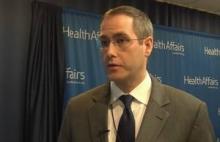WASHINGTON – Spending on physician and clinical services was the second biggest driver of the increase in health costs in 2011, according to the Centers for Medicare and Medicaid Services.
The nation spent $2.7 trillion on health care in 2011, or about $8,600 per person, according to an annual tally by CMS economists published Jan. 7 in the journal Health Affairs (2013;32:87-99).
The Affordable Care Act (ACA) had only a minimal impact on health spending in 2011, mainly because most of the provisions do not go into effect until 2014, according to the CMS officials.
Slightly more than 70% of the nation’s health bill is paid for by some form of insurance – 33% by private insurance, 21% by Medicare, and 15% by Medicaid, with the remainder paid by other programs.
Health spending has stayed relatively stable over the last 3 years, rising 3.9% in each of the years 2009, 2010, and 2011, which are historically low numbers. Health care also has consumed a similar share of the nation’s gross domestic product (18%) each year for the past few years.
Despite the stability, spending grew in certain areas, indicating that the nation could be poised for a rebound in spending growth. In particular, spending on prescription drugs and physician and clinical services grew faster than in previous years. But it’s not all bad news, according to Rick Foster, chief actuary for the CMS.
"There’s a growing amount of evidence that health care providers are getting it – getting that the future can’t be the same as the past – that the future will have to involve greater efforts for efficiency," Mr. Foster said at a briefing called by the CMS to discuss the analysis. He added that eventually, these efficiencies could offset other factors contributing to the growth in health spending.
Physician and clinical services are considered a single spending category by the CMS. Clinical services include outpatient care centers, freestanding ambulatory surgical centers, and medical and diagnostic labs.
In 2011, private and public payers spent $541 billion on physician and clinical services, accounting for 21% of the total $2.7 trillion health bill. Private health insurers covered 46% of the bill and Medicare paid 23%. Overall, there was a 4.3% increase in the growth of physician and clinical spending in 2011, which is still lower than the growth from 2002 to 2008. Physician spending, which accounts for 80% of the category, grew 3.6%, up from 2.8% the previous year.
The increase in growth was primarily driven by the complexity of services, said Micah Hartman, a statistician in the CMS Office of the Actuary, and the lead author of the report.
Physician and clinical spending also helped to drive an increase in Medicare spending, also due to increased complexity of care. But costs also went up as beneficiaries took advantage of free preventive services offered under the ACA, Mr. Hartman said.
Physician and clinical spending grew 7.6% in 2011, after 2 years of unusually slow growth. Overall, Medicare spent $554 billion in 2011. Seventy-five percent of that was spent on fee-for-service care; the remainder was spent for the Medicare Advantage program.
Medicaid spending shifted considerably in 2011.
Back in 2009, Medicaid saw a recession-related jump in enrollment. Federal legislation at the time increased the federal share of spending, cushioning the states from costs associated with the swell in enrollment. But by mid-2011, that increased federal match expired. As a result, the federal government’s Medicaid tab dropped by 7%, while the state share increased by 22%. Overall, states spent $29 billion more in 2011, even as they curbed benefits, restricted eligibility, and cut back on reimbursement rates, said Anne B. Martin, an economist in the CMS Office of the Actuary.
Another area where the health reform law may have had an impact was Medicare prescription drug spending. In 2011, Medicare beneficiaries spent less out of pocket because those who hit a spending level called the donut hole received a 50% discount on all additional brand name drugs.
That new benefit helped drive the growth of prescription drug spending to about 3%, compared to 0.4% in 2010.
Patients also shouldered a heavy load for those prescriptions and for other medical services. Out-of-pocket spending grew 3% in 2011, to $307 billion, accounting for 11% of total health spending. The increase was slightly more than in 2009-to-2010, but less than in the previous decade.
Patients spent more out-of-pocket in part because they are being asked to pay more by employer-sponsored plans and because increasingly, they are electing coverage through high-deductible health plans, also known as consumer-directed plans. Enrollment has grown by 20% a year the last few years; currently about 17% of insured Americans are in such plans, Mr. Hartman said.


